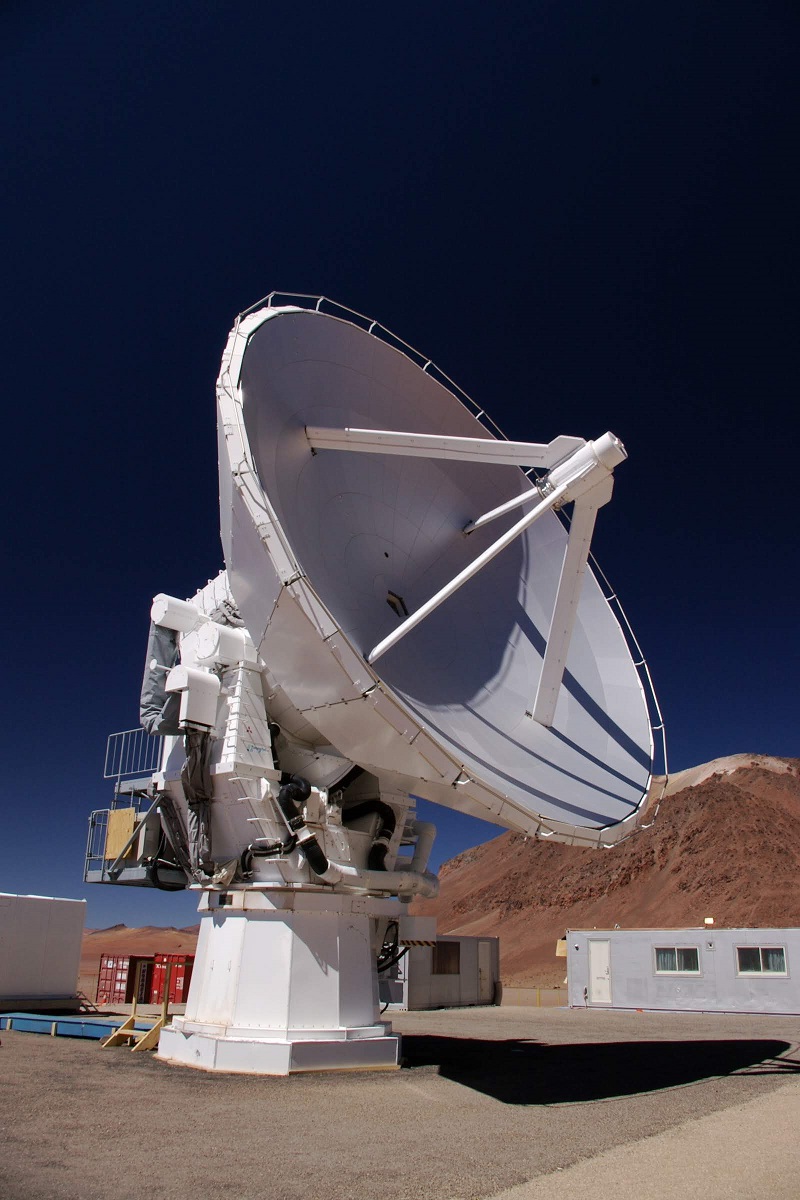(English follows Dutch)
Het DESHIMA-instrument van Nederlands-Japanse makelij heeft de eerste praktijktests doorstaan bij het meten van de afstanden en leeftijden van verre sterrenstelsels. De kern van het instrument is een chip ter grootte van twee euromunten die 49 tinten ver-infraroodlicht meet. De ontwikkelaars van de spectrometer publiceren de resultaten van hun eerste meetcampagne in Nature Astronomy.
Het meten van afstanden en leeftijden in het heelal is een probleem. De helderheid van een sterrenstelsel zegt namelijk weinig over de leeftijd. Sterrenkundigen omzeilen dat probleem door te kijken naar het dopplereffect in het licht van sterrenstelsels. Hoe roder het licht, hoe hoger de snelheid, hoe verder het sterrenstelsel. Het licht van de snelste, verste sterrenstelsels is op aarde te zien als ver-infraroodlicht.
49 kanalen
In oktober 2017 monteerden Nederlandse en Japanse onderzoekers onder leiding van Akira Endo (TU Delft) een supergeleidende chip op de ASTE-telescoop in Noord-Chili. Deze chip vormt de kern van het DESHIMA-instrument–ontwikkeld door TU Delft en SRON–en bevat één antenne, 49 filters en 49 detectoren. De antenne vangt straling van diverse golflengtes op. De filters rafelen de straling uiteen in 49 tinten infrarood. De 49 detectoren meten de sterkte van de straling. Als een detector een signaal opvangt, is dat te zien als een piek in een grafiek.
Eerste tests
De eerste tests met de telescoop waren veelbelovend. De astronomen hadden de telescoop-met-chip eerst op Mars, Saturnus en een aantal bekende sterren en sterrenstelsels gericht. Toen die zonder noemenswaardige problemen de verwachte helderheid waarnamen, richtten de onderzoekers de telescoop op het bekende verre sterrenstelsel VV114 en zagen ze de voorspelde roodverschuivingen.

Ruimtetelescoop
De onderzoekers werken inmiddels aan een chip die het licht uiteenrafelt in een golflengtegebied van meer dan 300 tinten in plaats van de huidige 49. Daarmee kunnen ze de afstanden bepalen tot sterrenstelsels die tot nu toe verborgen zijn achter stofwolken. Daarnaast willen de onderzoekers meerdere chips koppelen om meerdere sterrenstelsels tegelijk te bestuderen. De ontwikkeling moet leiden tot een imaging-spectrometer op handzaam formaat zodat die ook gebruikt kan worden op ruimtetelescopen.
Hulp van juwelier
Overigens mislukte de eerste tests op de telescoop in Chili nog bijna door materiaalproblemen. Er was namelijk wat mis met het koelsysteem van de chip. De onderzoekers hadden wel reserve-onderdelen meegenomen voor het koelsysteem, maar ze waren de pinnetjes vergeten om de onderdelen uit te lijnen. Na een urenlange zoektocht in het stadje San Pedro de Atacama kwamen de onderzoekers bij juwelier Jose Pinto. Ze vonden in Pinto’s gereedschapskist een stuk koperdraad met precies de goede diameter. Daarmee konden ze de vergeten pinnetjes maken.
Wetenschappelijke artikelen
Nature Astronomy
Journal of Astronomical Telescopes, Instruments and Systems
Documentaire DESHIMA-expeditie
Dutch-Japanese astronomy instrument detects 49 shades of far-infrared
The Dutch-Japanese-made DESHIMA instrument has passed its first practice runs measuring the distances and ages of distant galaxies. The core of the instrument is a chip the size of two euro coins that measures 49 shades of far-infrared light. The developers of the spectrometer publish the results of their first measurement campaign in Nature Astronomy.
Measuring distances and ages in the Universe is not trivial. The brightness of a galaxy reveals little about its age. Astronomers bypass this problem by looking at the Doppler effect in the light emitted by galaxies. The redder the light, the higher the velocity and the farther away the galaxy is. Light from the fastest, farthest galaxies is visible from Earth in the form of far-infrared radiation.
49 channels
In October 2017, Dutch and Japanese researchers, led by Akira Endo (TU Delft), mounted a superconducting chip on the ASTE telescope in northern Chile. This chip forms the core of the DESHIMA instrument—developed by TU Delft and SRON— and contains one antenna, 49 filters and 49 detectors. The antenna captures radiation of various wavelengths. The filters unravel this radiation into 49 shades of infrared. The 49 detectors measure the intensity of the radiation. If a detector picks up a signal, astronomers will see this because a peak will appear in a graph.
First test runs
The first test runs of the telescope show a lot of promise. The astronomers started off by focusing the telescope-with-chip on Mars, Saturn and a number of well-known stars and galaxies. When they observed the expected brightness without significant problems, the researchers pointed the telescope at the well-known distant galaxy VV114 and saw the predicted redshifts.

Space telescope
The researchers are now working on a chip that unravels light in a spectrum of more than 300 shades instead of the current 49. This allows them to determine the distance to galaxies that have hitherto been hidden behind dust clouds. In addition the researchers want to link multiple chips to study multiple galaxies at the same time. The development should lead to an imaging spectrometer of practical size so it can also be mounted on space telescopes.
Help from jeweler
Incidentally, the first test runs on the telescope in Chile almost failed due to material problems. There was something wrong with the cooling system of the chip. The researchers had brought spare parts for the cooling system, but forgot the pins to align the parts. After an hour-long search in the town of San Pedro de Atacama, the researchers came across jeweler Jose Pinto. They found a piece of copper wire with exactly the right diameter in Pinto’s toolbox, from which they could recreate the forgotten pins.
Scientific publications
Nature Astronomy
Journal of Astronomical Telescopes, Instruments and Systems


